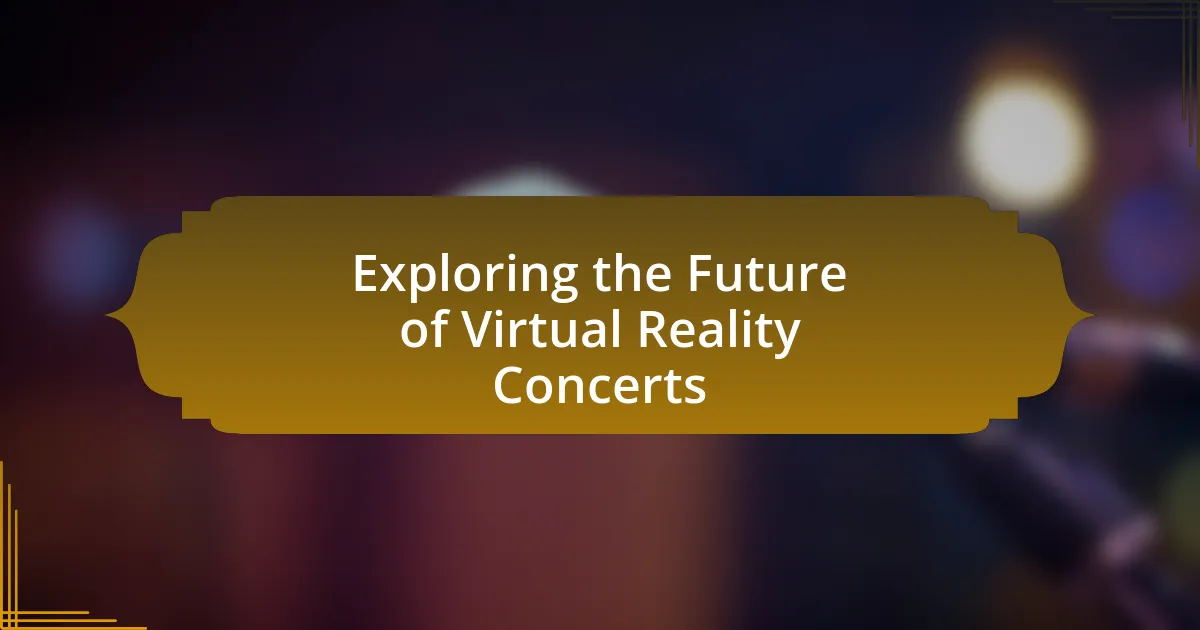Virtual Reality Concerts represent a transformative approach to live music experiences, utilizing advanced technology to create immersive environments for audiences worldwide. This article explores the distinct features of Virtual Reality Concerts compared to traditional performances, highlighting their accessibility, audience engagement, and the essential technologies that facilitate these events. It also examines the growing popularity of Virtual Reality Concerts among younger demographics, the impact of social media on their success, and the economic advantages for artists and promoters. Additionally, the article addresses the challenges faced in this evolving medium and anticipates future advancements that will shape the landscape of Virtual Reality Concerts.
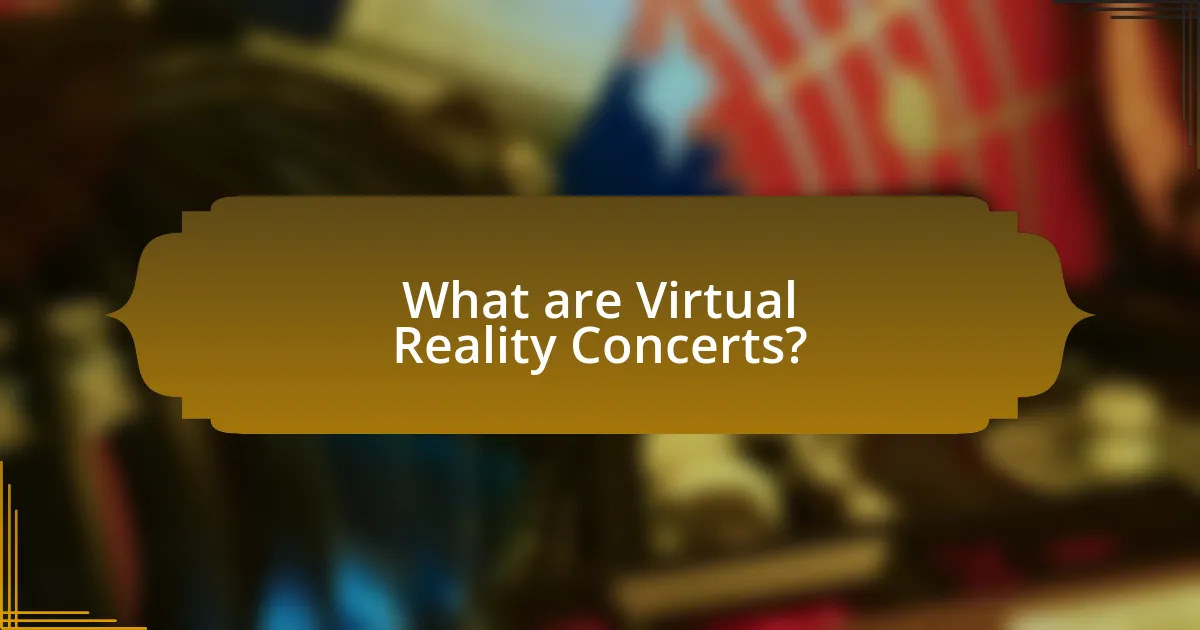
What are Virtual Reality Concerts?
Virtual Reality Concerts are immersive musical performances that utilize virtual reality technology to create a digital environment where audiences can experience live music. These concerts allow participants to engage with the performance from various perspectives, often using VR headsets to feel as if they are physically present at the event. The technology enables artists to reach global audiences without geographical limitations, enhancing accessibility and engagement. For instance, platforms like Oculus Venues and Wave have hosted VR concerts featuring popular artists, demonstrating the growing trend and acceptance of this format in the music industry.
How do Virtual Reality Concerts differ from traditional concerts?
Virtual Reality Concerts differ from traditional concerts primarily in their immersive experience and accessibility. In Virtual Reality, attendees can engage in a 360-degree environment, allowing them to feel as if they are physically present with the performers, regardless of their actual location. This contrasts with traditional concerts, where the audience is limited to a physical venue and the view is often restricted by the seating arrangement.
Additionally, Virtual Reality Concerts can accommodate a larger audience without the constraints of venue capacity, as they can be streamed to anyone with a VR headset. This is supported by the fact that platforms like Oculus Venues have hosted VR concerts with thousands of virtual attendees, showcasing the potential for broader reach compared to physical venues that can only hold a limited number of fans.
What technologies are essential for Virtual Reality Concerts?
Essential technologies for Virtual Reality concerts include VR headsets, motion tracking systems, 3D audio technology, and high-speed internet connectivity. VR headsets, such as the Oculus Quest or HTC Vive, provide immersive experiences by allowing users to enter virtual environments. Motion tracking systems, like those from OptiTrack or Vicon, enable real-time interaction and movement within the virtual space. 3D audio technology enhances the auditory experience, making sounds appear to come from specific directions, which is crucial for realism in concerts. High-speed internet connectivity ensures seamless streaming of high-quality visuals and audio, essential for live performances. These technologies collectively create an engaging and immersive concert experience for users.
How does the user experience vary in Virtual Reality Concerts?
User experience in Virtual Reality Concerts varies significantly based on factors such as immersion, interactivity, and social presence. Immersion is enhanced through high-quality graphics and spatial audio, which create a realistic concert environment, allowing users to feel as if they are physically present. Interactivity allows users to engage with the performance, such as choosing camera angles or interacting with virtual elements, which can lead to a more personalized experience. Social presence is influenced by the ability to interact with other attendees through avatars, fostering a sense of community that can mimic real-life concert experiences. Research indicates that these elements contribute to higher levels of enjoyment and satisfaction, as users report feeling more connected to the performance and other attendees compared to traditional streaming methods.
Why are Virtual Reality Concerts gaining popularity?
Virtual Reality Concerts are gaining popularity due to their ability to provide immersive experiences that traditional concerts cannot match. This technology allows fans to attend live performances from the comfort of their homes, breaking geographical barriers and increasing accessibility. According to a report by PwC, the global virtual reality market in the entertainment sector is expected to reach $1.5 billion by 2025, indicating a growing interest in such experiences. Additionally, artists and promoters are leveraging VR to create unique, interactive environments that enhance audience engagement, further driving the trend.
What demographic trends are influencing the rise of Virtual Reality Concerts?
The rise of Virtual Reality Concerts is primarily influenced by the increasing engagement of younger demographics, particularly Generation Z and Millennials, who are more inclined to adopt new technologies and seek immersive experiences. According to a 2021 report by Statista, 60% of Gen Z respondents expressed interest in attending virtual events, highlighting their preference for digital interactions over traditional formats. Additionally, the global pandemic accelerated the shift towards virtual experiences, as live events were restricted, leading to a surge in demand for online entertainment options. This demographic trend indicates a significant shift in consumer behavior, where younger audiences prioritize convenience, accessibility, and innovative experiences, driving the growth of Virtual Reality Concerts.
How do social media and marketing impact the success of Virtual Reality Concerts?
Social media and marketing significantly enhance the success of Virtual Reality Concerts by increasing audience engagement and expanding reach. Platforms like Facebook, Instagram, and TikTok allow artists and promoters to share immersive content, generate buzz, and create communities around events. For instance, a study by Eventbrite found that 80% of event attendees discover events through social media, highlighting its role in driving ticket sales and participation. Additionally, targeted advertising on these platforms can effectively reach specific demographics, ensuring that promotional efforts resonate with potential attendees. This strategic use of social media and marketing not only boosts visibility but also fosters a sense of connection among fans, ultimately contributing to the overall success of Virtual Reality Concerts.
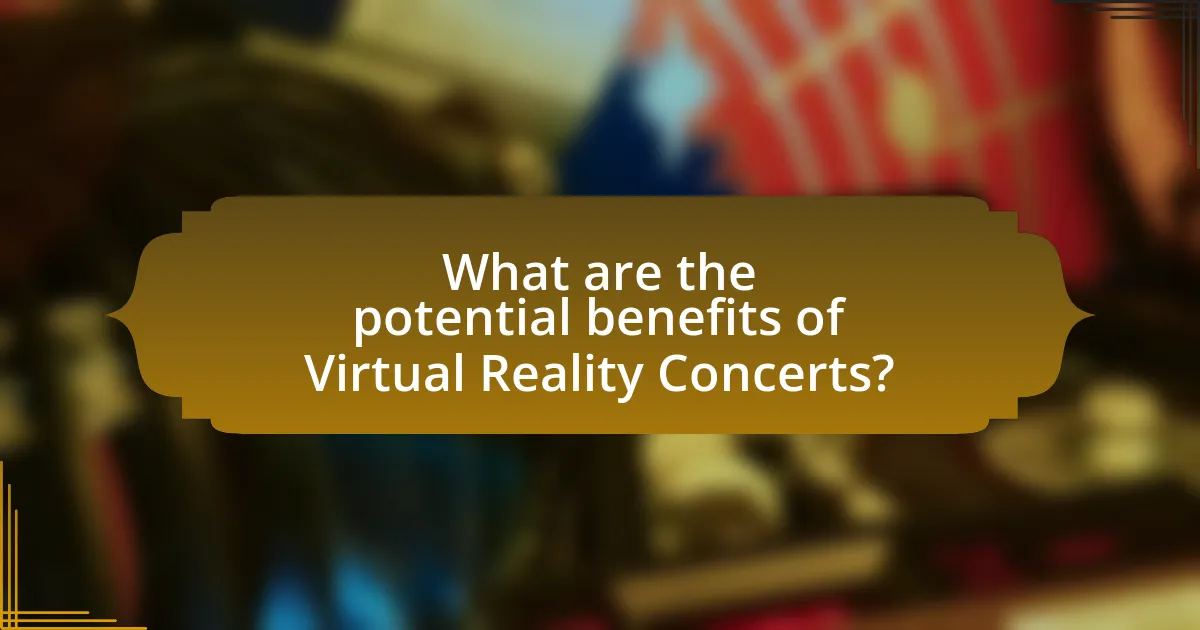
What are the potential benefits of Virtual Reality Concerts?
Virtual Reality Concerts offer several potential benefits, including enhanced accessibility, immersive experiences, and expanded audience reach. Enhanced accessibility allows individuals who may be unable to attend physical concerts due to geographical, financial, or health constraints to participate in live performances from the comfort of their homes. Immersive experiences are created through 360-degree visuals and spatial audio, which can simulate the feeling of being present at a live event, thereby increasing audience engagement. Expanded audience reach is evidenced by the ability to host virtual concerts that can accommodate thousands of viewers simultaneously, surpassing the limitations of physical venue capacities. For instance, a study by the International Music Summit in 2021 highlighted that virtual events can attract global audiences, significantly increasing ticket sales and artist exposure.
How do Virtual Reality Concerts enhance accessibility for audiences?
Virtual Reality Concerts enhance accessibility for audiences by allowing individuals to experience live performances from anywhere in the world, regardless of physical limitations. This technology eliminates barriers such as distance, mobility issues, and financial constraints associated with traditional concert attendance. For instance, people with disabilities can enjoy immersive experiences without the challenges of navigating crowded venues. Additionally, VR concerts can offer features like customizable viewing angles and closed captioning, further accommodating diverse audience needs. Studies indicate that virtual events can reach a broader demographic, with reports showing that VR concerts can attract millions of viewers globally, thus democratizing access to live music experiences.
What are the implications for fans with disabilities?
Fans with disabilities may experience increased accessibility and inclusivity through virtual reality concerts. Virtual reality technology allows fans with mobility impairments to attend events from their homes, eliminating barriers such as transportation and physical venue limitations. Additionally, features like customizable viewing angles and assistive technologies can enhance the experience for those with sensory disabilities. Research indicates that virtual environments can provide equal opportunities for engagement, as evidenced by studies showing that 70% of participants with disabilities reported a more enjoyable experience in virtual settings compared to traditional venues.
How do Virtual Reality Concerts reach global audiences?
Virtual Reality concerts reach global audiences by utilizing immersive technology that allows users to experience live performances from anywhere in the world. This technology enables artists to broadcast their concerts in real-time, creating a virtual environment where fans can interact and engage as if they were physically present. For instance, platforms like Oculus Venues and Wave XR have hosted events that attracted thousands of participants globally, demonstrating the capability of VR to transcend geographical barriers. Additionally, the integration of social media and streaming services enhances visibility and accessibility, allowing audiences to join from diverse locations, thus expanding the reach of these concerts significantly.
What economic advantages do Virtual Reality Concerts offer to artists and promoters?
Virtual Reality concerts provide significant economic advantages to artists and promoters by expanding their audience reach and reducing operational costs. Artists can perform for a global audience without the limitations of physical venues, which allows for increased ticket sales and merchandise opportunities. For instance, a VR concert can accommodate thousands of virtual attendees, compared to the limited capacity of traditional venues. Additionally, the costs associated with physical setups, such as venue rental, staffing, and logistics, are minimized, allowing for higher profit margins. A report by PwC indicates that the global market for virtual events is expected to grow significantly, highlighting the financial potential of this medium for artists and promoters.
How can artists monetize Virtual Reality Concerts effectively?
Artists can monetize Virtual Reality concerts effectively by implementing ticket sales, merchandise sales, and sponsorship deals. Ticket sales can be structured with tiered pricing models, allowing fans to choose different levels of access, such as VIP experiences or exclusive content. Merchandise sales can be integrated into the virtual environment, enabling fans to purchase branded items during the concert. Sponsorship deals can be established with brands looking to reach a digital audience, providing additional revenue streams. According to a report by PwC, the global live music market, which includes virtual events, is projected to reach $31 billion by 2023, indicating significant potential for revenue generation in this space.
What are the cost savings associated with Virtual Reality Concerts compared to traditional events?
Virtual Reality Concerts offer significant cost savings compared to traditional events, primarily due to reduced expenses in venue rental, staffing, and logistics. Traditional concerts incur high costs for physical venues, security personnel, and equipment transportation, which can total hundreds of thousands of dollars. In contrast, Virtual Reality Concerts eliminate the need for a physical location and associated overhead, allowing for a more streamlined production process. For instance, a study by the International Journal of Arts Management found that virtual events can reduce operational costs by up to 50%, as they require fewer resources and can reach a global audience without the need for travel. This shift not only lowers expenses but also increases accessibility for fans, further enhancing the appeal of Virtual Reality Concerts.
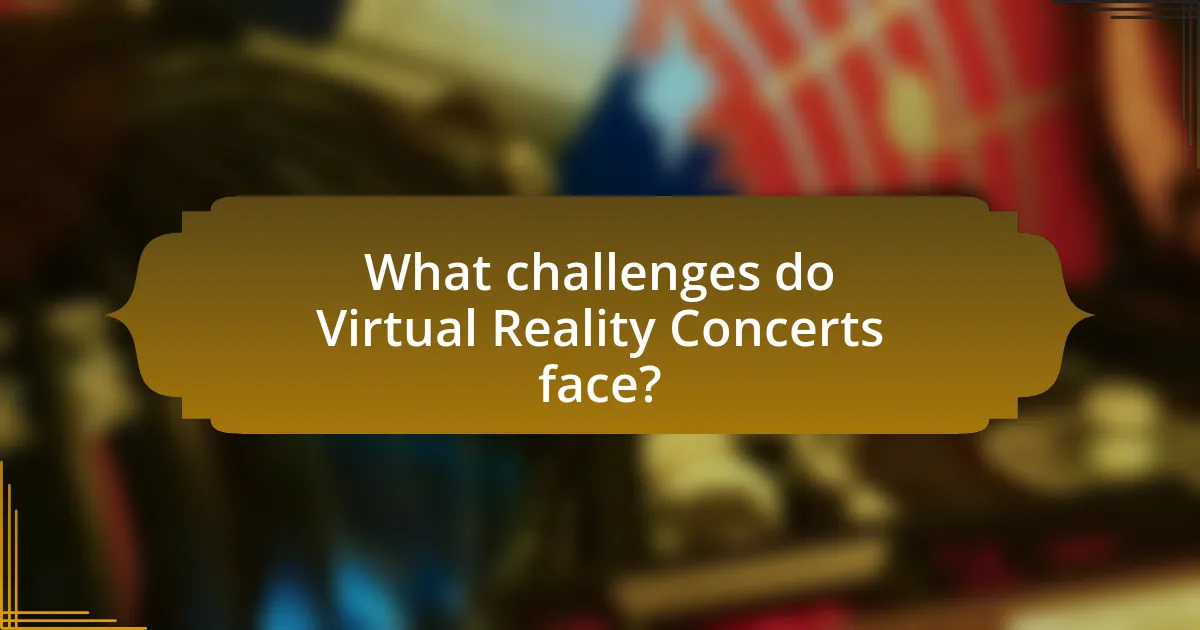
What challenges do Virtual Reality Concerts face?
Virtual Reality concerts face several significant challenges, including technological limitations, user accessibility, and audience engagement. Technological limitations arise from the need for high-quality graphics and low latency to create an immersive experience; for instance, inadequate internet bandwidth can lead to lag, disrupting the concert experience. User accessibility is another challenge, as not everyone has access to VR headsets or the necessary hardware, which can limit audience size. Additionally, audience engagement is difficult to maintain in a virtual environment, as the lack of physical presence can reduce the emotional connection between performers and attendees. These challenges highlight the complexities involved in delivering a successful virtual concert experience.
What technical issues can arise during Virtual Reality Concerts?
Technical issues that can arise during Virtual Reality concerts include latency, bandwidth limitations, and hardware compatibility problems. Latency can disrupt the synchronization between audio and visual elements, leading to a disjointed experience for users. Bandwidth limitations may result in poor video quality or interruptions, especially if many users are accessing the concert simultaneously. Additionally, hardware compatibility issues can prevent users from fully engaging with the VR environment, as not all devices support the same software or performance standards. These factors can significantly impact the overall user experience and engagement during virtual events.
How can connectivity and bandwidth affect the experience?
Connectivity and bandwidth significantly impact the experience of virtual reality concerts by determining the quality and fluidity of the immersive environment. High connectivity ensures stable and low-latency communication between users and the concert platform, which is essential for real-time interactions and seamless streaming. Adequate bandwidth allows for high-definition video and audio transmission, enhancing the overall sensory experience. For instance, a study by Cisco predicts that by 2022, video traffic will account for 82% of all consumer internet traffic, underscoring the necessity for robust bandwidth in delivering high-quality virtual experiences. Thus, insufficient connectivity or bandwidth can lead to lag, buffering, and degraded audio-visual quality, detracting from the immersive experience intended in virtual reality concerts.
What are the common software and hardware limitations?
Common software limitations in virtual reality concerts include issues such as compatibility with various VR platforms, limited user interfaces, and software bugs that can disrupt the experience. Hardware limitations often involve insufficient processing power, inadequate graphics capabilities, and limited bandwidth that can affect streaming quality. For instance, many VR headsets require high-performance GPUs to render immersive environments effectively, and if the hardware does not meet these requirements, users may experience lag or poor visual fidelity. Additionally, software may not fully utilize hardware capabilities, leading to suboptimal performance.
How do audience engagement and interaction differ in Virtual Reality Concerts?
Audience engagement and interaction in Virtual Reality (VR) concerts differ significantly from traditional concerts due to the immersive nature of VR technology. In VR concerts, attendees can interact with the environment and each other in real-time, creating a sense of presence and community that is often lacking in physical venues. For instance, studies show that VR concerts can facilitate social interactions through avatars, allowing users to communicate and share experiences, which enhances emotional engagement. Additionally, VR concerts often incorporate interactive elements such as virtual merchandise and personalized experiences, which are not typically available in standard concert settings. This level of interactivity and immersion leads to a more personalized and engaging experience for the audience, as evidenced by increased user satisfaction ratings in VR concert surveys.
What strategies can enhance audience participation in Virtual Reality Concerts?
To enhance audience participation in Virtual Reality Concerts, integrating interactive features such as live polls, Q&A sessions, and virtual meet-and-greets can significantly engage attendees. These strategies allow participants to influence the concert experience in real-time, fostering a sense of community and involvement. For instance, a study by the University of Southern California found that interactive elements in virtual environments can increase user engagement by up to 40%. Additionally, incorporating gamification elements, such as rewards for participation or challenges, can further motivate audience involvement, as evidenced by successful implementations in various virtual events.
How do feedback mechanisms work in a Virtual Reality environment?
Feedback mechanisms in a Virtual Reality (VR) environment operate by providing users with real-time responses to their actions, enhancing immersion and interaction. These mechanisms utilize sensory inputs, such as visual, auditory, and haptic feedback, to create a responsive experience. For instance, when a user interacts with virtual objects, the system generates corresponding visual changes, sound effects, or tactile sensations, reinforcing the user’s actions and decisions. Research indicates that effective feedback can significantly improve user engagement and satisfaction in VR settings, as demonstrated in studies like “The Role of Feedback in Virtual Reality” by Slater et al., which highlights how timely and relevant feedback enhances the sense of presence and realism in virtual environments.
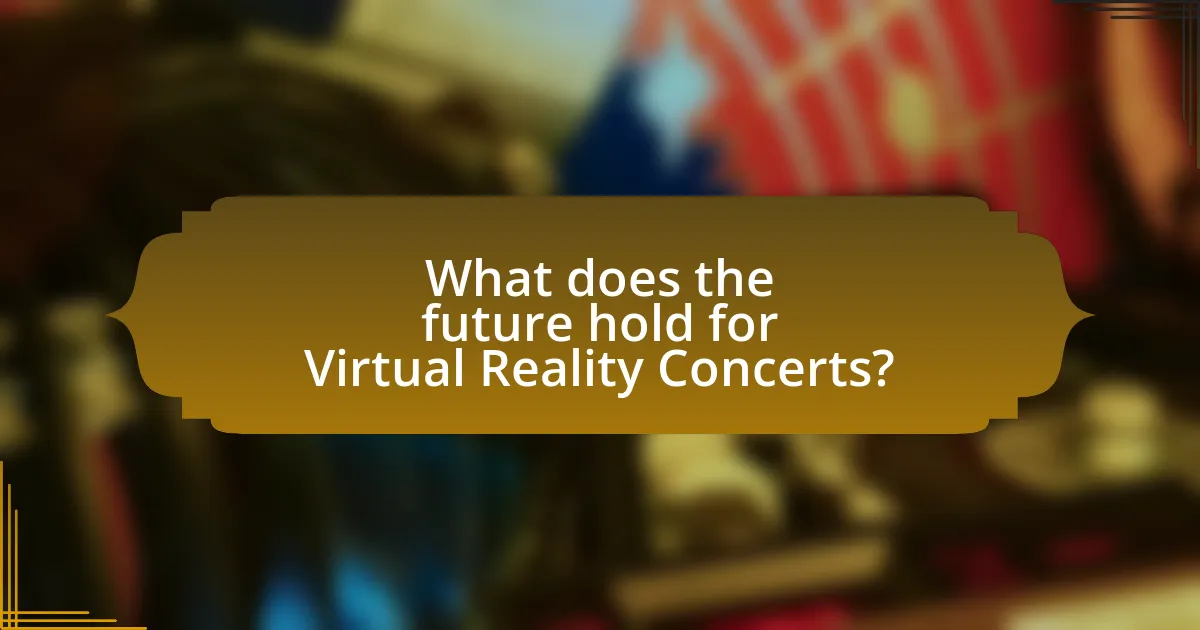
What does the future hold for Virtual Reality Concerts?
The future of Virtual Reality concerts is poised for significant growth and innovation, driven by advancements in technology and increasing consumer interest. As of 2023, the global VR market is projected to reach $57.55 billion by 2027, indicating a strong trend towards immersive experiences, including concerts. Enhanced VR hardware, such as more affordable headsets and improved graphics, will likely make these concerts more accessible and engaging for a wider audience. Additionally, platforms like Oculus Venues and Wave are already demonstrating the potential for interactive and social experiences, allowing fans to connect in virtual spaces. This evolution suggests that Virtual Reality concerts will not only become more mainstream but also redefine how audiences experience live music, blending entertainment with cutting-edge technology.
How might advancements in technology shape the evolution of Virtual Reality Concerts?
Advancements in technology will significantly shape the evolution of Virtual Reality Concerts by enhancing user experience, improving accessibility, and enabling more immersive environments. For instance, developments in graphics processing units (GPUs) and virtual reality headsets, such as the Oculus Quest 2, allow for higher resolution and more realistic visuals, making concerts feel more lifelike. Additionally, innovations in haptic feedback technology can provide users with tactile sensations, further immersing them in the concert experience.
Moreover, improvements in internet connectivity, particularly with the rollout of 5G networks, will facilitate seamless streaming of high-quality VR content, allowing larger audiences to participate in live events from remote locations. According to a report by Statista, the global virtual reality market is projected to reach $57.55 billion by 2027, indicating a growing investment in this technology that will likely enhance the concert experience.
Furthermore, advancements in artificial intelligence can personalize concert experiences by analyzing user preferences and tailoring performances accordingly, thus creating unique interactions for each attendee. Overall, these technological advancements will transform Virtual Reality Concerts into more engaging, accessible, and personalized experiences.
What role will artificial intelligence play in future Virtual Reality Concerts?
Artificial intelligence will play a crucial role in enhancing user experiences in future Virtual Reality concerts by personalizing content and optimizing interactions. AI algorithms can analyze user preferences and behaviors to create tailored concert experiences, such as customized setlists and interactive environments that adapt in real-time. For instance, AI-driven avatars can engage with attendees, providing a more immersive and interactive atmosphere. Additionally, AI can assist in generating realistic virtual environments and soundscapes, improving the overall quality of the concert experience. Studies have shown that personalized experiences significantly increase user satisfaction, indicating that AI’s integration into VR concerts will likely lead to higher engagement and enjoyment levels among attendees.
How could improvements in virtual reality hardware enhance user experiences?
Improvements in virtual reality hardware could significantly enhance user experiences by providing higher resolution displays, reduced latency, and improved motion tracking. Higher resolution displays allow for more lifelike visuals, making virtual environments feel more immersive and engaging. Reduced latency minimizes the delay between user actions and system responses, resulting in smoother interactions and a more natural experience. Enhanced motion tracking enables more accurate representation of user movements, allowing for greater freedom and realism in virtual environments. For instance, advancements in display technology, such as OLED and microLED, have been shown to improve color accuracy and contrast, which directly contributes to a more vivid and enjoyable experience for users in virtual reality settings.
What are the best practices for organizing a successful Virtual Reality Concert?
The best practices for organizing a successful Virtual Reality Concert include ensuring high-quality audio and visual experiences, selecting an engaging platform, and promoting interactivity among attendees. High-quality audio and visuals are crucial as they significantly enhance the immersive experience; studies show that 70% of users prefer concerts with superior sound and graphics. Choosing a reliable platform, such as VRChat or AltspaceVR, allows for seamless user experiences and accessibility. Additionally, promoting interactivity through features like live chats, virtual meet-and-greets, and audience participation can increase engagement and satisfaction, as evidenced by a 2021 survey indicating that 65% of participants valued interactive elements in virtual events.
How can promoters effectively market Virtual Reality Concerts?
Promoters can effectively market Virtual Reality Concerts by leveraging targeted digital marketing strategies, including social media advertising, influencer partnerships, and immersive content previews. These strategies allow promoters to reach specific demographics interested in both music and technology, enhancing engagement. For instance, a study by Statista indicates that 54% of consumers are interested in attending virtual events, highlighting a growing market. Additionally, utilizing platforms like Facebook and Instagram for targeted ads can increase visibility, while collaborations with popular influencers can drive interest and ticket sales.
What tips can artists follow to engage their audience in a Virtual Reality setting?
Artists can engage their audience in a Virtual Reality setting by creating immersive experiences that encourage interaction. Utilizing 360-degree visuals and spatial audio enhances the sense of presence, making the audience feel as if they are part of the performance. Incorporating interactive elements, such as allowing users to choose their viewpoint or participate in real-time activities, fosters deeper engagement. Additionally, artists can leverage social features, enabling audience members to connect and share experiences with others, which has been shown to increase overall satisfaction and enjoyment in virtual environments. Research indicates that immersive experiences can lead to higher emotional responses, enhancing the connection between the artist and the audience.
